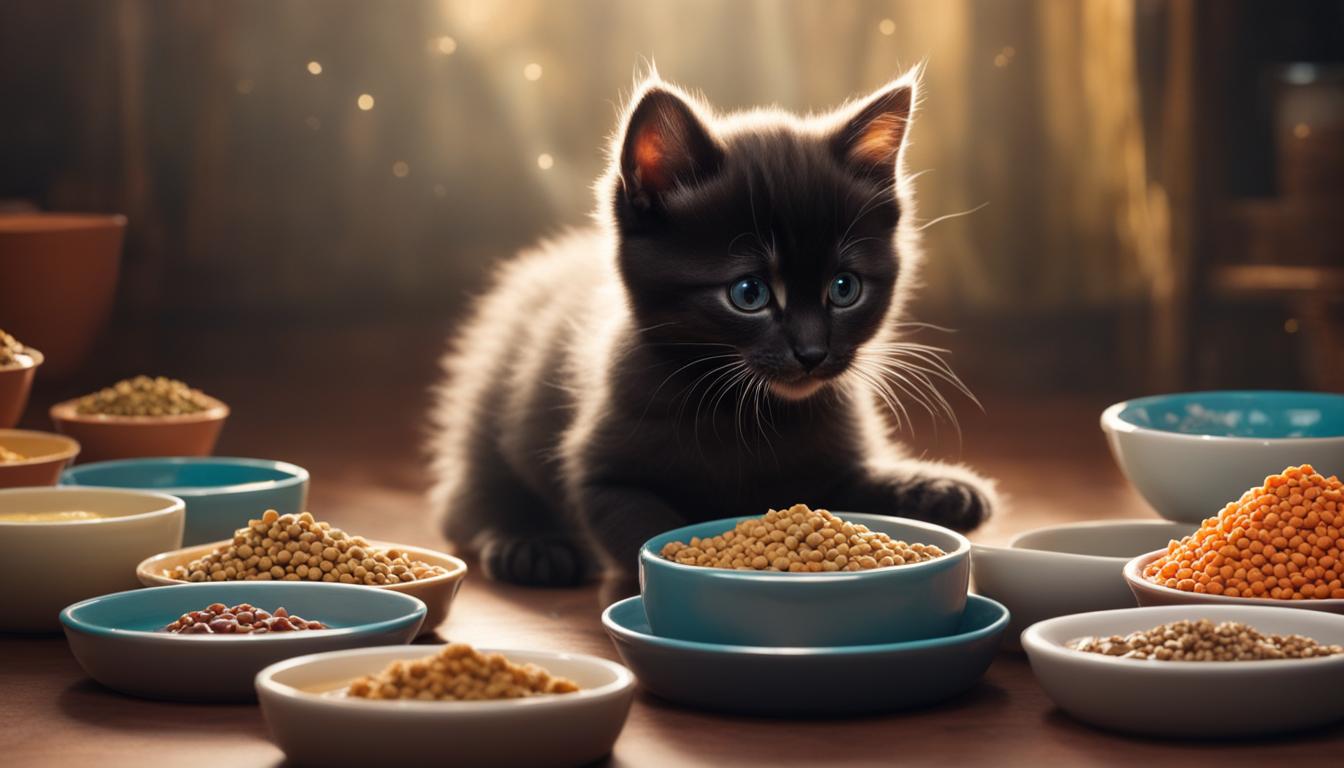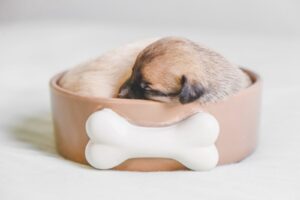Welcome to our comprehensive guide on when and how to feed a kitten. As a new kitten owner, it’s important to understand the nutritional needs and feeding schedule that will ensure your fur baby grows up healthy and strong. In this guide, we’ll cover everything from what to feed a kitten to the best feeding practices for young kittens.
Key Takeaways:
- Knowing when to feed a kitten and establishing a feeding schedule is crucial for their proper growth and development.
- Kittens have specific nutritional needs that require a balanced diet of proteins, vitamins, minerals, carbohydrates, and calcium.
- For newborn kittens, feeding charts and bottle-feeding may be necessary until they are ready to transition to solid food.
- At 6 to 8 weeks, kittens can start eating wet or dry food, and it’s important to choose high-quality options formulated for kittens.
- During adolescence, kittens require a diet that supports their energy levels and growth, with a focus on animal-based proteins and fish oils.
Now, let’s dive into the details of each stage of a kitten’s life and explore the best feeding practices and tips to ensure your furry friend receives the nutrition they need.
Understanding Kitten Feeding Needs
Kittens have unique feeding needs that are essential for their healthy growth and development. Understanding these needs is crucial for ensuring that your kitten receives the proper nutrition. Here are the key aspects to consider:
- Kitten Developmental Needs: Kittens are rapidly growing and developing, which requires a diet that supports their unique nutritional requirements. Their diet should promote muscle growth, skeletal development, and the healthy functioning of organs.
- Kitten Diet: A balanced kitten diet should include the following essential nutrients:
- Protein: High-quality animal-based proteins are crucial for muscle growth and development.
- Vitamins: Kittens require a variety of vitamins, such as vitamin A, B, D, and E, for overall health and immunity.
- Minerals: Minerals like calcium, phosphorus, and magnesium are essential for bone development and overall growth.
- Carbohydrates: Carbohydrates provide energy and are an important part of a kitten’s diet.
- Importance of Calcium: Calcium is particularly crucial for kittens as it helps in the development of strong bones and teeth. It is essential to provide your kitten with a diet that includes an adequate amount of calcium.
By understanding and meeting these feeding needs, you can ensure that your kitten receives the proper nutrition for optimal growth and development.
Feeding Newborn Kittens: Birth to 4 Weeks
Feeding newborn kittens requires special attention and care to ensure their proper growth and nutrition. In the first four weeks of their lives, these tiny furballs rely entirely on their mother’s milk for nourishment. However, there may be situations where additional feeding becomes necessary.
When bottle-feeding newborn kittens, it is crucial to provide them with a formula that closely resembles their mother’s milk, as their delicate digestive systems are not yet equipped to handle other types of food. A veterinarian can recommend a suitable formula and provide guidance on proper feeding techniques.
It’s important to note that newborn kittens should be fed every two hours, even during the night, to match their fast metabolism and promote steady growth. An appropriately sized bottle and nipple should be used, ensuring that the kittens are able to feed comfortably. As newborns approach four weeks of age, weaning can be gradually introduced, integrating soft food into their diet and transitioning them away from bottle feeding.
It’s always recommended to consult with a veterinarian to ensure that the kittens receive the necessary nutrition and monitor their overall health during this critical developmental stage.
Growing Up: 6 to 8 Weeks
At 6 to 8 weeks, kittens reach a crucial stage in their development where they can begin transitioning to solid food. This is an exciting milestone as it marks their journey towards independence and self-sufficiency. When it comes to feeding kittens at this age, you have a few options to consider:
- Wet food for kittens: Wet food is a popular choice for many kitten owners due to its high moisture content. It provides hydration and can be easier for kittens to eat and digest. Look for wet food options specifically formulated for kittens to ensure they receive the necessary nutrients.
- Dry food for kittens: Dry food, also known as kibble, offers convenience and can help promote dental health by encouraging chewing. Look for dry food that is designed for kittens, as their nutritional needs differ from adult cats. Ensure that the food contains high-quality ingredients and is free from artificial additives.
It’s important to introduce solid food gradually during this period. Start by mixing a small amount of wet or dry food with formula or water to create a soupy texture. Offer this mixture to the kittens in shallow dishes or saucers. As they become more comfortable with the texture, you can increase the amount of solid food and reduce the liquid. Monitor their eating habits and make sure they are eating adequately.
During this stage, it’s also crucial to provide clean water for the kittens to drink. Water should be readily available at all times to keep them hydrated. You can use a shallow dish or a water fountain designed for cats. Encourage them to drink by placing the water source near their food and making sure it’s easily accessible.
Feeding Schedule for Kittens at 6 to 8 Weeks:
| Time | Meal |
|---|---|
| Morning | Wet or Dry Food |
| Afternoon | Wet or Dry Food |
| Evening | Wet or Dry Food |
Remember to closely monitor the kittens’ progress during this transition period. If you notice any signs of digestive upset or refusal to eat, consult with a veterinarian for further guidance. Every kitten is unique, and the feeding process may vary depending on their individual needs and preferences.
Adolescence: 8 Weeks to 10 Months
During adolescence, kittens go through a period of rapid growth and development. They become more active and energetic, requiring a diet that meets their increased energy requirements. Feeding adolescent kittens properly is crucial for their overall health and well-being.

Energy Requirements for Kittens
Adolescent kittens have higher energy requirements compared to younger kittens. This is because they are growing rapidly and engaging in more physical activity. To meet their energy needs, it is important to provide them with food that is rich in proteins, which are essential for muscle development and repair.
Protein for Adolescent Kittens
Type: Animal-based proteins, such as chicken or turkey, are highly recommended for adolescent kittens. These proteins provide essential amino acids that support healthy growth and development.
Fish Oils for Kittens
In addition to proteins, adolescent kittens can benefit from the inclusion of fish oils in their diet. Fish oils are a great source of omega-3 fatty acids, which promote brain development, support a healthy coat, and aid in joint health.
Feeding Schedule for Adolescent Kittens
At this stage, adolescent kittens can handle larger portions and should be fed at least twice a day. It’s important to establish a consistent feeding schedule to provide them with the necessary nutrients. Make sure to monitor their weight and adjust the portion size accordingly to prevent overfeeding or underfeeding.
| Age | Number of Meals |
|---|---|
| 8-12 Weeks | 3-4 meals per day |
| 12-26 Weeks | 2-3 meals per day |
| 26 Weeks – 10 Months | 2 meals per day |
Remember to provide clean water at all times to keep kittens hydrated and maintain good overall health.

By following a proper feeding schedule and providing a balanced diet, you can ensure that your adolescent kittens thrive during this crucial stage of their development.
Young Adults: Over 10 Months
As your kitten grows into a young adult, their nutritional needs will change. It’s important to transition them to adult cat food to ensure they continue to receive the proper nutrients for their development. However, some breeds, like Maine Coon kittens, may require a longer period of feeding kitten food.
Around 10 months of age, you can start transitioning your kitten to adult cat food. Slowly introduce the new food by mixing it with their current kitten food over the course of a week or two. This gradual transition will allow their digestive system to adjust to the new diet and prevent any gastrointestinal issues.
For certain breeds, such as Maine Coons, it is recommended to continue feeding them kitten food for a longer period. Maine Coons are known for their large size and longer growth period, so feeding them kitten food until they reach 12-18 months may be beneficial. Consult with your veterinarian to determine the best time to transition your Maine Coon kitten to adult cat food.
| Breed | Recommended Transition Timeline |
|---|---|
| Maine Coon | 12-18 months |
| Other Breeds | Around 10 months |
Each breed may have different feeding needs and growth patterns, so it’s always best to consult with your veterinarian to ensure you’re providing the best nutrition for your young adult cat. They can provide personalized recommendations based on your cat’s specific breed and individual needs.

By understanding the breed-specific feeding needs of your young adult cat and following a proper feeding transition timeline, you can ensure that they continue to thrive and grow into healthy adult cats.
Wet Food Vs. Dry Food: What’s Best for Kittens?
When it comes to feeding your kitten, you may find yourself wondering whether to choose wet food or dry food. Both options have their advantages and disadvantages, and it’s important to consider your kitten’s specific needs and preferences.
Advantages of Wet Food
Wet food for kittens offers several benefits. First and foremost, it provides hydration. Kittens are prone to dehydration, and wet food contains higher moisture content compared to dry food. Additionally, wet food is generally more palatable and appealing to kittens due to its texture and aroma. It can be especially beneficial for kittens with dental issues or those who are picky eaters. Wet food also helps support urinary health by increasing the moisture intake.
Advantages of Dry Food
Dry food for kittens also has its advantages. One key benefit is dental health. The crunchiness of dry food helps to remove plaque and tartar buildup, promoting good oral hygiene. Dry food is also more convenient to store and feed, as it does not require refrigeration. It can be left out for longer periods without spoiling, making it suitable for free-feeding or when you’re away for extended periods. Dry food is also generally more cost-effective than wet food.
Disadvantages to Consider
While both wet and dry food have their advantages, there are some drawbacks to be aware of. Wet food is more expensive and has a shorter shelf life once opened. It needs to be refrigerated and discarded if left out for too long. On the other hand, dry food can lead to obesity if overfed, as it is more calorie-dense. It may also be less appealing to kittens who prefer soft textures. Additionally, kittens may not drink enough water when consuming dry food alone, potentially leading to urinary tract problems.
| Advantages | Disadvantages | |
|---|---|---|
| Wet Food | Provides hydration, palatable, supports urinary health | More expensive, shorter shelf life, needs refrigeration |
| Dry Food | Promotes dental health, convenient, cost-effective | Potential for obesity, less appealing, may lead to decreased water intake |
The best approach to feeding your kitten is to provide a balanced diet that incorporates both wet and dry food. By alternating between the two, you can enjoy the benefits of each while minimizing the drawbacks. Consult with your veterinarian for personalized recommendations based on your kitten’s specific nutritional needs and preferences.
Meal Frequency for Kittens
Feeding your kitten the right amount of food and at the right times is crucial for their growth and development. The meal frequency for kittens varies depending on their age and individual needs. In this section, we will discuss the recommended feeding schedule for kittens and provide guidance on portion sizes.
Feeding Schedule for Kittens
For newborn kittens, feeding should occur every 2 hours around the clock. Their tiny stomachs can only hold small amounts of milk at a time, so frequent feedings are necessary to meet their nutritional needs. As the kittens grow, their feeding schedule can be adjusted. At around 4 weeks old, you can start introducing solid food and gradually reduce the number of feedings to around 6 times a day.
By the time your kitten reaches 8 weeks old, they can be fed 4 times a day. At this age, they can handle larger portions and their stomach capacity increases. It’s important to establish a consistent feeding routine to help them develop good eating habits. As they continue to grow, the number of daily feedings can be reduced to 2-3 times a day.

Kitten Meal Portions
The portion size for each kitten meal will depend on their age and weight. It’s important to follow the guidelines provided on the kitten food packaging and consult with your veterinarian for personalized advice. Generally, a good rule of thumb is to offer about 1/4 to 1/3 cup of food per feeding for kittens 8 weeks and older. This can be divided into multiple meals throughout the day.
Remember to monitor your kitten’s weight and adjust their portion sizes accordingly. Overfeeding can lead to weight gain and potential health issues, while underfeeding can result in nutritional deficiencies. Regularly weigh your kitten and consult with your veterinarian to ensure they are on the right track.
| Age | Meal Frequency | Portion Size |
|---|---|---|
| Newborn to 4 weeks | Every 2 hours | 1-2 tablespoons of formula |
| 4 to 8 weeks | 6 times a day | 1/4 to 1/3 cup of kitten food |
| 8 weeks and older | 2-3 times a day | 1/4 to 1/3 cup of kitten food |
Keep in mind that these are general guidelines and individual kittens may have different needs. It’s important to observe your kitten’s behavior, body condition, and consult with your veterinarian for personalized feeding recommendations.
In conclusion, establishing a proper meal frequency and portion size is essential for the health and well-being of your kitten. Following a consistent feeding schedule and monitoring their weight will help ensure they receive the right amount of nutrition at each stage of their development. Remember to provide fresh water at all times, and consult with your veterinarian for any specific dietary recommendations or concerns.
Conclusion
Feeding a kitten properly is crucial for their overall health and development. This comprehensive guide serves as your go-to resource for determining when and how to feed your kitten based on their age and nutritional needs. Remember to consult with your veterinarian for personalized feeding advice tailored to your specific kitten.
Understanding your kitten’s unique feeding needs is essential. From birth to 4 weeks, newborn kittens rely on their mother’s milk, but additional feeding may be necessary. As they grow, the introduction of wet or dry food can begin at 6 to 8 weeks, with high-quality options formulated specifically for kittens. Adolescence, from 8 weeks to 10 months, requires an energy-rich diet with proteins and fish oils to support their active and growing bodies.
As your kitten reaches young adulthood, around 10 months, transitioning to adult cat food may be appropriate. However, certain breeds, such as Maine Coons, may have specific feeding needs that require a longer period of feeding kitten food. It’s always best to consult with your veterinarian to ensure you’re meeting your kitten’s nutritional requirements.
In the ongoing debate between wet food and dry food, both options have benefits and disadvantages. Wet food provides hydration and supports urinary health but can be more expensive and perishable. Dry food is convenient and aids in dental health but may contribute to obesity. Consider alternating between the two for a well-rounded diet.
In conclusion, understanding the needs of your growing kitten and following a proper feeding regimen are essential for their optimal well-being. By providing them with the right nutrition at the right times, you are setting them on the path to a healthy and happy life as they mature into thriving adult cats.
FAQ
When should I start feeding a kitten solid food?
Kittens can start eating solid food at around 6 to 8 weeks of age. It’s important to choose a food formulated specifically for kittens and gradually introduce it into their diet.
How often should I feed a newborn kitten?
Newborn kittens should be fed every 2 hours, including during the night. As they grow, the feeding frequency can be gradually reduced.
How do I transition a kitten from formula to solid food?
Weaning should begin around 4 weeks of age. You can introduce soft food mixed with formula and gradually increase the amount of solid food while decreasing the formula over a span of a few weeks.
Should I choose wet or dry food for my kitten?
Both wet and dry food have their advantages. Wet food provides hydration and supports urinary health, while dry food is good for dental health and convenience. Consider alternating between the two for a balanced diet.
How much should I feed my kitten per meal?
The amount per feeding should be adjusted based on the kitten’s age and weight. Consult a feeding chart or your veterinarian for specific guidelines to prevent overfeeding or underfeeding.
When can I transition my kitten to adult cat food?
Kittens can typically be transitioned to adult cat food around 10 months of age. However, some breeds may require a longer period of feeding kitten food. Consult with your veterinarian for personalized advice.




